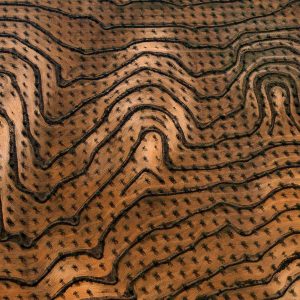Olive groves, Tunisia – Yann Arthus-Bertrand Photography
These olive groves at the foot of the 4,250-foot-high (1,295 m) Jebel Zaghouan in northeastern Tunisia are planted in curved embankments to retain water and limit erosion, which viewed from above look like the lines on a relief map. A symbol of peace, the tree is native to the Mediterranean basin, where 90% of the planet’s olive trees grow. An olive tree can live as long as 1,000 years, producing 11 to 65 pounds (5 to 30 kg) of olives yearly. In the past its oil was used in small clay lamps, but it has been replaced by petroleum. Today we consume both table olives and olive oil, which is renowned for its dietary and medicinal properties and also used in cosmetics. The lands of the Mediterranean are the greatest olive producers and also the greatest consumers. The Greeks consume 18 litres of olive oil per person per year, and the Italians and the Spaniards 13 litres, compared to 1.4 litres a year in France and 0.6 litres in the United States.

